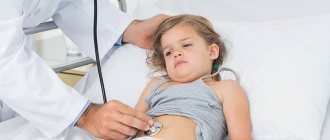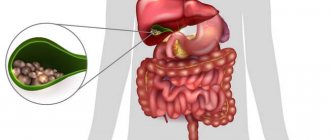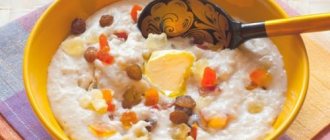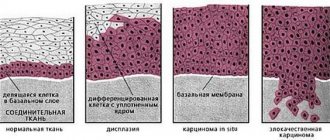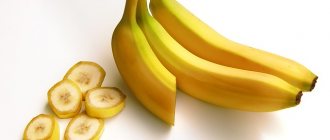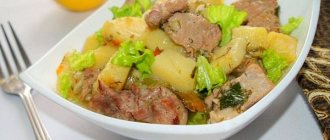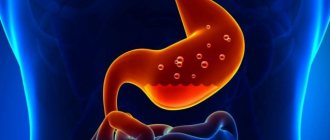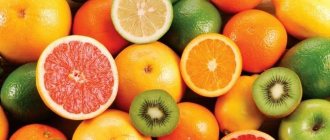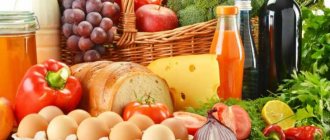A diet for biliary dyskinesia has two goals - improving bile drainage and normalizing the functioning of the digestive tract. With JVP, they reduce the consumption of refractory lipids, which load the hepatobiliary system - bile ducts, liver, bile ducts. Patients with dyskinesia are prescribed table No. 5 - a gentle diet that stimulates the functions of the affected organs.
Diet principles
With dyskinesia, the active vital activity of bile currents becomes significantly lower, which is why this fluid remains in the liver, ducts and bladder for a long time. The bile ducts themselves become clogged, clogged and inflamed.
JVP in adults usually manifests itself as colic on the right side of the body, severe nausea leading to vomiting, bitterness and a specific taste in the mouth, and bloating. The doctor makes a conclusion about the disease based on test results and symptoms, and prescribes appropriate treatment. But sometimes diet can help cope with such disorders.
A special diet for biliary dyskinesia is designed to restore and improve the functioning of the bile duct, liver, and help in building normal function of other organs of the digestive tract.
Dietary nutrition should adhere to the following basic rules:
- The number of meals per day is 5–6 times, no less.
- The time for breakfast, lunch, dinner, snacks - it should be the same every day.
- Cooking method: no frying, only boiling or steaming.
- Temperature: not cold and not very hot - you need to eat food only warm so that it is tasty and comfortable.
- No spices - pepper, salt, spices are prohibited, as is sugar.
- Drink as much water as possible - you need to drink about 2-2.5 liters of clean water without gas per day.
- Eat more foods containing fiber - vegetables, fruits.
During a disorder of the biliary apparatus, what can you eat? Only proper, low-fat foods rich in vitamins and minerals. In addition, it is worth including in the daily menu of a person with such a pathology products whose components slow down the crystallization of bile - eggs (yolks), low-fat cottage cheese, beef, low-fat fish and seafood.
Doctors also prescribe vitamins that will help treat pathology, improve the process of digesting food and support the body as a whole.
Diet for ADHD in a child
For children, prohibited foods are the same as for adults, but the recipes have their own nuances:
- First courses can be prepared with onions. After cutting, you need to keep it in boiling water for 15 minutes. After draining the water, without frying, add the onion to the soup.
- Vegetable soups can be supplemented with meat. It is cooked separately, into meatballs, then placed on a plate with the first course.
- Vegetable oil (especially unrefined) is a choleretic product with anti-inflammatory properties. It is recommended to add a tablespoon to soups and side dishes.
- A child should eat sweets no more than once a day. They contain sugar, so it is advisable to replace them with a sweet dish (mousse, fruit puree).
- In the afternoon or as a second breakfast, you can eat (always with drinks) dry cookies or dry biscuit.
- After eating, children are advised to lie down for a while, placing a warm heating pad under their right side.
Sample menu for ADHD in children:
- have breakfast with 100 grams of porridge with milk, drink jelly;
- for the 2nd breakfast, drink fruit juice or eat fruit;
- At lunch, eat Lenten borscht, after - stewed fish;
- in the afternoon, drink yogurt or eat apples baked in the oven;
- dine on a steam omelette with 100 grams of boiled chicken breast;
- Before going to bed, drink a glass of low-fat kefir.
Authorized Products
For patients with a record of this disorder in their medical records, it makes sense to pay special attention to which foods can be eaten and which are strictly prohibited.
An approximate “white list” of ingredients for the diet:
- Vegetable oil is indicated for use for biliary dyskinesia.
- Vegetables fruits. Priority is given to vegetables with a high content of fiber and starch (all kinds of cabbage, zucchini, potatoes, bell peppers), fruits (apples, grapes, bananas). Just before eating they need to be boiled or made into jelly.
- Kefir and cottage cheese with a small percentage of fat content.
- Egg yolk dishes.
- White poultry (necessarily without skin), lean meat (beef), lean fish.
- No fresh bread, only dried bread; crackers, diet biscuits and unsalted crackers are good options.
- Drinks: tea with milk (very weak), herbal teas and infusions.
Sample menu for the week
For dyskinesia, it is recommended to follow a diet constantly. A balanced diet prevents thickening of liver secretions and stone formation.
Sample menu for gastric dyskinesia
| Days of the week | 1 breakfast | 2 breakfast | Dinner | Afternoon snack | Dinner |
| Monday | muesli with dried fruits, cottage cheese with sour cream, tea with sorbitol | baked pear with honey, peach juice | cream soup with vegetables, vermicelli with meatloaf, chamomile infusion | cottage cheese casserole, compote | baked potatoes with meat soufflé, vinaigrette, tea |
| Tuesday | buckwheat porridge, cookies, tea | cottage cheese casserole, carrot juice | puree soup with carrots and broccoli, steamed chicken cutlets, sliced vegetables, compote | cheesecakes with sour cream, rosehip broth | vegetable stew, meat soufflé, broccoli salad, tea |
| Wednesday | semolina porridge with dried apricots, bread, beet juice | banana, carrot juice | vegetarian borscht, steamed meat cutlets, lettuce, chamomile infusion | cottage cheese casserole, tea | baked pollock with mashed potatoes, sliced vegetables, compote |
| Thursday | 2 sandwiches with hard cheese, weak coffee | applesauce, vegetable juice | vegetarian soup, baked fish with vermicelli, compote | cottage cheese with prunes, jelly | pilaf with vegetables and chicken, tomato and cucumber salad, tea |
| Friday | carrot pancakes, dried fruits, weak tea | casserole with apples and pears, rosehip broth | lean borscht, pilaf with veal, lettuce, jelly | casserole with pumpkin, vegetable juice | fish casserole with boiled potatoes, tea |
| Saturday | toast with zucchini caviar, homemade yogurt | baked pear with honey, herbal infusion | slimy oatmeal soup, mashed potatoes with boiled chicken, coffee | 100 g dried apricots, low-fat kefir | baked hake with carrots, vegetable salad, chamomile infusion |
| Sunday | muesli with milk, egg white omelette, coffee | 100 g dried apricots or prunes, compote | pureed vegetable soup, boiled veal, vegetables, juice | baked fruits with honey, rosehip infusion | vegetable stew, meatloaf, weak tea |
The diet should be balanced and varied. Eating the same foods is dangerous due to hypovitaminosis and worsening dyskinesia.
Prohibited Products
What is prohibited if there is a violation of the bile flow, and what foods are definitely prohibited:
- Grapes without proper processing must be excluded.
- Pickles, smoked meats.
- Sweets and chocolate.
- Of course, alcohol and alcohol should be completely, categorically excluded from the diet.
- Nuts.
- Various seasonings, including ginger.
- Lard, butter and other fats.
- Dark poultry meat, especially with skin.
- By-products, sausages, frankfurters.
- Berries, oranges, tangerines, lemons.
- French fries, pizza, sushi, sandwiches, hamburgers, soda.
- Fresh bread, buns, pastries.
- Strong coffee, especially when brewed from ground coffee, strong tea.
All of the above ingredients for or stand-alone dishes should be removed from your refrigerator, at least for the duration of treatment. And treatment is usually quite long. You will have to follow the diet for up to six months.
Dish recipes
Patients diagnosed with dyskinesia can eat vegetables, fish and meat baked in the oven or stewed in their own juice.
Lenten vegetarian soup (2 servings):
- Required ingredients: carrots (1 pc.), potatoes (1 pc.), pearl barley (30 g).
- Vegetables are rinsed, peeled and chopped, cut into small pieces.
- Vegetable broth (1.5 l) is poured into the pan, boiled and pre-washed barley is added.
- After the water boils under the pan, reduce the heat and cook the cereal for 45-50 minutes.
- To make pearl barley cook faster, you can pre-soak it for half an hour in warm water.
- After the cereal is cooked until half cooked, carrots and potatoes are added to the soup.
- The first dish is simmered over low heat for another 15 minutes. Salt and remove the pan from the heat. The soup can be served with herbs.
Baked fish:
- Pike or pike perch fillet (150 g) is washed in cold water and lightly salted.
- The fish is wrapped in foil and baked in the oven at 180° C for 30-45 minutes.
- To prevent the fillet from being dry, you can brush it with olive oil.
- A side dish of cereals and vegetables will be prepared for the fish: potatoes and carrots are stewed in their own juice without adding oil.
- Rice or pearl barley is boiled in unsalted water until tender.
Boiled beef:
- Lean beef fillet (150 g) is washed under running water and thrown into boiling water.
- After the meat has boiled, the broth is drained, the fillet is washed, and placed in boiling unsalted water.
- The meat is boiled until done.
- You can serve the dish with mashed potatoes or any other side dish.
Curd and fruit casserole:
- Low-fat cottage cheese (100 g), honey (1 tablespoon) are mixed in one container.
- Banana (1 piece) is peeled and cut into small slices.
- The cottage cheese is placed in a fireproof form.
- Banana slices are placed on top of the curd and honey mixture.
- Cover the pan with foil and place in the oven preheated to 150°C for 30 minutes.
Vegetable salads are prepared in the standard way. Gastroenterologists recommend pre-boiling vegetables in unsalted water. You can use olive oil as a dressing.
Which diet to choose
As already mentioned above, nutrition for biliary dyskinesia should be made correct, rationally balanced. Some doctors are confident that, ideally, patients are recommended the so-called table No. 5, which is prescribed to patients diagnosed with cholecystitis, for others associated with biliary ailments or various biliary disorders.
Moreover, it is worth dividing the described pathology into a diagnosis of hypotonic type and hypertensive type. The diet for biliary dyskinesia will vary slightly, depending on what type of disease is diagnosed in a particular patient. Nutrition for biliary dyskinesia of the hypotonic type is simply reduced to diet No. 5. But with greater inclusion in the daily consumption of products and substances that thin, disperse bile and help remove this fluid painlessly from the body. This principle of nutrition will also help with cholelithiasis in removing stagnant heavy bile. It is also important to use choleretic drugs for hypokinetic types of pathology.
And in case of pathology of the hypertensive type, the total consumption of fats is significantly reduced. It even happens that vegetable oil is removed from the menu altogether.
For both types, it is important that the diet be balanced. How to eat? The amount of proteins is no more than 90 grams (about half are vegetable), fats are up to 80 grams (about a third of them are vegetable. In the hypertensive type it is reduced or completely eliminated), carbohydrates are up to 300 grams. The diet for biliary dyskinesia should contain a little more than 2000 calories in the daily diet.
It is important to adhere to your eating schedule. Five to six doses a day and always at the same hours.
So, you can imagine a set of food rations for the day and for the week, what kind of menu is possible:
- Breakfast. Kashi porridge, boiled cereal in water, pureed, served warm. Wash it down with permitted drinks. For example, warm weak tea without sugar. You can add milk and cottage cheese to your breakfast,
- After 2.5 hours, snack - cottage cheese, kefir - optional. Everything should be low in fat and a little - a glass of kefir, cottage cheese - 150 grams. You can have fresh cottage cheese with yogurt,
- Two and a half hours after the previous meal - lunch. For first courses, broths made from fish, chicken or meat, boiled fish, poultry brisket or a piece of beef are suitable. Dishes can be boiled, steamed, prepared soups, chicken, fish and pieces of meat can be pureed or smashed in a blender, and then poured with broth. In addition, vegetable juices and bran bread are suitable. Fresh baked goods are prohibited.
- After another two and a half hours - afternoon tea. You can eat fruit during this meal. Only boiled or baked
- And after another 2-3 hours (but no later than three hours before bedtime) dinner. You can fish or again cottage cheese with a small amount of kefir.
This or that national favorite dish can be included in the diet. But only if its components do not contradict general principles, rules, indications and prohibitions.
But fasting is prohibited. It is impossible to help them with both hypermotor and hypertensive dyskinesia. You can only make it worse - the body will weaken and stop fighting the disease.
Usually, the symptoms that bother you against the background of this pathology should decrease after eating. And the further you go, the more the signs of the diagnosis should decrease. During diseases of the biliary tract, the diet during exacerbation should be even more gentle.
Selection of products for diarrhea
Consumption of foods containing many lipotropic substances increases the fluidity of bile, and the content of oxalic acid or cholesterol leads to thickening and promotes stone formation. Purine bases impair metabolism. It is allowed to drink mineral water, but it must be non-carbonated. If there is no exacerbation, you can eat honey (a little).
What you can eat:
- Porridge, cereals.
- Starchy vegetables, fresh herbs.
- Baked or boiled fruits, diluted fruit juices.
- Boiled meat, fish (necessarily low-fat varieties).
- Vegetable soups (meat broth cannot be used).
- Jam, marmalade, marshmallows, marshmallows.
- Rye or wheat bread. Fresh ones need to be dried or left to sit for a day.
- Vegetable oils.
What to limit in your diet:
- Semolina, rice cereals.
- Sugar (within 30 grams per day).
- Eggs (no more than 3 per week).
What not to eat:
- Fried, fatty, spicy.
- Smoked, canned food, marinades, pickles.
- Offal.
- Store-bought sauces (ketchup, mayonnaise).
- Carbonated drinks.
- Fast food, sushi, chips.
- Fresh bread, pastries made from butter dough.
- Chocolate, ice cream.
- Fatty lactic acid products.
- Nuts, mushrooms, legumes.
- Garlic, radish, onion, sorrel, radish.
- Instant porridge.
- Chewing gum.
Diet for children
Unfortunately, this diagnosis also occurs in young patients. Moreover, for example, Dr. Komarovsky is sure that such an illness in children is not at all uncommon.
Symptoms of biliary dyskinesia in children are slightly more pronounced than in adult patients. Let's say that in addition to all the above pathology marks, headaches, severe and constant fatigue, and fatigue are also added. Excessive sweating and tachycardia are also possible.
The diet for biliary dyskinesia in children is not much different from the diet for a similar pathology in adults. The main rule for such a diagnosis in a child is that calorie content cannot be strictly established. It should be calculated according to the energy consumption of a small patient. To do this, you should always have a table of caloric content of different components of dishes at hand.
A diet for stagnation of bile should be accompanied by the introduction of foods or herbal decoctions into the menu that help dilute and disperse this fluid.
Diet therapy
Diet is an important treatment for gastrointestinal dyskinesia in children. It is often the main method of treating this pathology. This is why it is so important to know the rules of diet therapy to achieve maximum effect on the functional restoration of the child’s gallbladder.
The basic principles of the diet for ADHD are:
- steaming, boiling or baking food;
- fractional feeding of the child at least 5 times a day - each meal causes the release of bile from the gallbladder into the intestines;
- portions should not exceed 250 g, and the interval between feedings should not be more than 4 hours, overeating and starvation are excluded;
- the last feeding should occur 3 hours before bedtime;
- dishes should be at room temperature (cold food can cause spasms, that is, reduction of the lumen, bile ducts, hot food can cause discomfort and irritation);
- Grinding food should be done in case of hypertonic dyskinesia, but in case of hypotonic dyskinesia this is not necessary;
- calorie content is calculated in accordance with the child’s energy consumption: insufficient energy intake will lead to fatty degeneration of the liver, death of liver cells and the development of connective tissue;
- restriction in the diet of refractory, difficult-to-digest animal fats (pork, lamb, beef, duck, goose), which contribute to fatty hepatosis;
- It is allowed to consume animal fat in the form of butter - it is easier to digest and contains arachidonic acid and retinol that are beneficial to the body;
- broths containing extractive substances are subject to restrictions;
- Chips, fast food, sausages, salted nuts, chocolate, cocoa, carbonated drinks, chewing gum are also excluded;
- salt intake is reduced to 8 g per day;
- It is mandatory to drink at least 1.5 liters of fluid per day.
Consequences of a poor diet
Only strong-willed people and those patients who really want to get rid of the hated diagnosis on their chart can follow a complete diet for a long time. Those who like to deviate from the established rules should know: if you do not eat according to the specified diet, you can “earn” inflammation of the biliary or biliary tract, which can easily transform from acute to chronic. It is also possible to develop gallstone disease. All this leads to malfunctions in the functioning of other organs of the food processing and digestion system in the body.
In the worst case scenario, failure to comply with the required diet will lead to amputation of the gallbladder. This is the first thing you need to remember when you really want to relax and eat or drink something forbidden. And then you will have to eat according to the specified diet for the rest of your life.
Symptoms of biliary dyskinesia in children
With the hypertensive type of disease, the child is concerned about the following symptoms:
- acute pain in the right hypochondrium;
- vomiting, nausea;
- belching of bile;
- sweating, tachycardia;
- weakness, asthenia;
- heartburn.
With hypotonic dyskinesia, there is a lack of bile production. This affects the child’s well-being as follows:
- inflammatory process in the gallbladder;
- aching pain in the right hypochondrium;
- constipation;
- bitterness in the mouth;
- nausea after eating.
Features of nutrition for hypertensive dysfunction
This form of the disorder is characterized by increased motor and motor function of the gallbladder and sphincters at the border of the gallbladder and the excretory tract, as well as the bile duct and duodenum. Hypertonicity of the sphincters leads to congestion in the bladder and ducts, which negatively affects the composition and properties of bile. Dyskinesia of the biliary tract requires nutrition aimed at relieving hyperkinesia of the bile storage, hypertension of the bile outlet.
Warm liquids are recommended for drinking, such as: weak tea, non-concentrated fruit juices, compotes, herbal mixtures that enhance the excretion of bile. It is better to avoid mineral carbonated water, as it provokes increased formation of bile, which will lead to overflow of the gallbladder and ducts, the appearance of hepatic colic, and attacks of severe pain.
Steamed and boiled food is allowed. It is necessary to reduce salt consumption to the possible minimum, exclude raw foods, fresh vegetables and fruits, spicy, salted, smoked foods, as they cause irritation of the autonomic nervous system and increased hypertonicity of the gallbladder. The diet for gallbladder dyskinesia excludes sweets and starchy foods, because they cause bloating and constipation. Fatty, spicy and smoked foods provoke hepatic colic, belching, nausea, and intestinal spasms.
The frequency of meals should not be less than 5 times a day. You need to eat in small portions. Their size depends on gender; for women, a single portion of food should not exceed 150 grams, for men – 200–250 grams. This is useful for complete digestion and absorption of the necessary substances in food. They do not cause sudden, abundant production of bile, thereby aggravating the patient’s condition.
The food should be warm. Cold food increases the motor and motor activity of the walls of the biliary apparatus, which is contraindicated in the hypertensive form of dyskinesia.
Particular attention should be paid to products containing a good supply of magnesium. This chemical element relaxes the smooth muscles of the gallbladder and reduces the contractile activity of the sphincters. Smoking and alcohol should be excluded.
Biliary dyskinesia requires a diet, which must be followed throughout the entire treatment process, as well as 4-5 months after it - to completely restore the functioning of the biliary apparatus.

